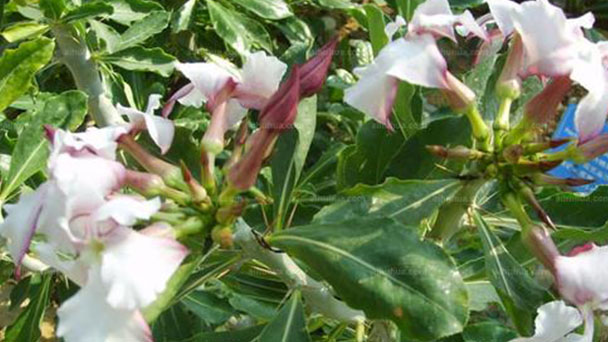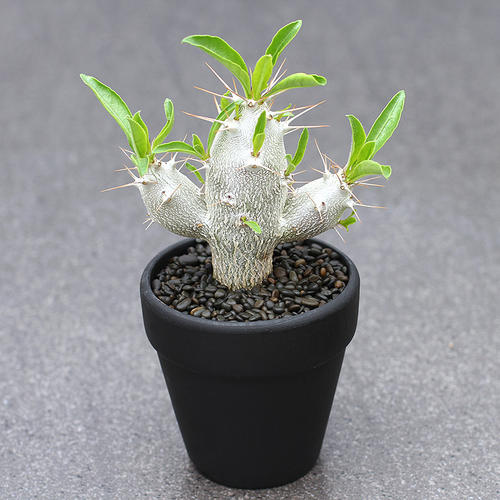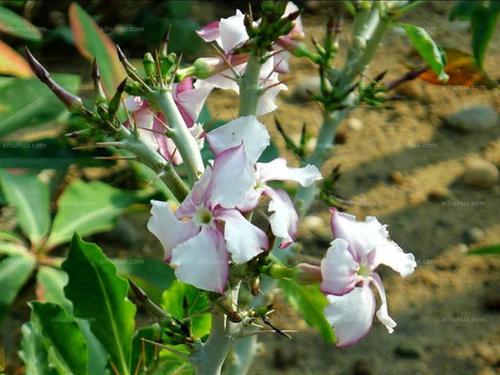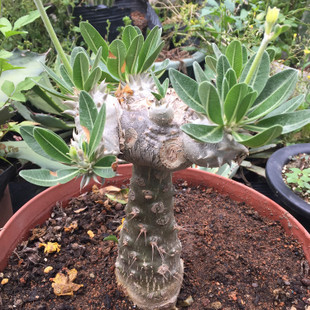Pachypodium Saundersii (Kudu Lily) Profile
Written by Maggie
Oct 14 2021

Pachypodium saundersii, commonly called kudu lily, is an attractive young plant with a thick, slender stem with a silvery-white skin, clustered leaves and a stem tip that spreads like an umbrella. Pachypodium saundersii is worth collecting for lovers.
Pachypodium Saundersii Picture

Pachypodium Saundersii Features
Pachypodium saundersii is a fleshy, flowery, stemlike plant with a tuber of 1, 5 -- 2M tall and 1M wide. The base of the stem is enlarged and thin, branching and cavelike, and the epidermis is silvery white. Scatter growth spines, 3 spines a cluster of grayish brown. Green leaves are 4-8 x 3 cm, fascicled stem tips umbellate. pachypodium saundersii has slightly short hair. Flowers are saucer-shaped, white or reddish, with red stripes between the petals. Pachypodium saundersii will regrow new leaves as soon as the temperature is right in the spring. Flowering period is in autumn. The leaves and flowers of the Pachypodium saundersii are all withered and stripped, becoming bare pinprick sticks.
Pachypodium Saundersii Habits
Pachypodium saundersii is grown from spring to autumn at an optimum temperature of 18-32 degrees. It prefers high temperature, high humidity and bright light. Pachypodium saundersii should avoid standing water. It should be permeable and rich in humus and calcareous loam (leaf rot, 6 parts of river sand and a small amount of eggshell or shell powder can be used. Growing period should be fully watered, the temperature to 12 degrees below to resolutely cut off water.
Pachypodium Saundersii Distribution
Pachypodium Saundersii is located in Zimbabwe, South Africa. Oleander family Claspora is generally mainly cultivated and ornamental.

Pachypodium Saundersii Propagation
Pachypodium saundersii are sown in late spring and germinate at 19-24 ° C. They can also be propagated from top stem cuttings.
Pachypodium Saundersii Care
1. Watering
Pachypodium Saundersii (Kudu Lily) is a high temperature, high humidity, strong light, growing season from March to November, optimum temperature for growth is 18-32 degrees. In the growing season there should be sufficient water supply, the temperature below 12 degrees should be determined to break water. Winter aquaculture can basically break water, keep the basin soil dry and safely pass the winter. When watering do not cause basin soil water, especially to the rainy summer, but also to strictly control the water.
2. Soil
Pachypodium Saundersii requires a soil that is well permeable and rich in humus and calcareous loam. This can be done with leaf rot, river sand and a small amount of eggshell or shell powder. When used, the soil should be screened for dust and larger particles and disinfected.
3.Light
Pachypodium Saundersii is demanding of high light situations and suffers in dark, shady locations. Most are full sun plants in the wild. If grown indoors, keep in a southwest facing window ideally (these plants may need to be turned periodically from leaning toward the light and growing crookedly).
4. Fertilizer
Fertilizer Kudu Lily is not usually needed if one is going to repot their plants every 2-3 years. But otherwise a gentle liquid fertilizing in summers is probably not a bad idea, and may promote flowering. It is recommended to use a standard fertilizer that has even quantities of all three major nutrients, or perhaps a tad heavy on the phosphorus in summer. Some provide extra potash or potassium in the summer and fall to help improve winter hardiness (a common practice with Pachypodium Saundersii growers) if growing these outdoors in marginal climates.

Latest Updated
- Benefits of Bugleweed - 7 Science-backed Health Benefits
- Bugleweed Dangers & Side Effects - Is It Poisonous?
- How to Plant Evergreen Trees - What You Should Know
- When to Plant Evergreens - Grow Guide for Evergreen Trees
- 12 Wonderful Evergreen Shrubs for Your Garden
- 12 Popular Evergreen Plants with Pictures for Beginners
- When And How To Prune A Lilac Bush Like a Pro
- How to Grow & Care for Lilac Vine (Hardenbergia Violacea)
- Japanese Lilac Tree (Syringa Reticulata) Care & Propagation Guide
- Shumard Oak Pros and Cons - What to Know
Popular Articles
- Winter maintenance of Antirrhinum Majus
- How to Grow Terminalia Mantaly Tree
- How to Grow and Care for Crossostephium Chinense
- How to grow Antirrhinum Majus in spring
- Peristeria Elata (Dove Orchid) Profile: Info & Care Guide
- Underwatered Snake Plant (Sansevieria Trifasciata) - Signs And How To Fix
- How to Care for Brazilian Jasmine Plant (Mandevilla Sanderi)
- How to Grow & Care for Graptopetalum Purple Delight in Summer
- Rosa Chinensis (China Rose): Plant Growing & Care Tips
- How to Care for Baby Sun Rose (Aptenia Cordifolia)